London School of Commerce: GPA Company's International Business Report
VerifiedAdded on 2022/11/30
|10
|2560
|177
Report
AI Summary
This report analyzes the international business strategy of GPA Company, a Brazilian retail company, for entering the Chinese market. The report begins with an overview of GPA, its products, and its readiness for internationalization, specifically targeting China. It then critically evaluates the macro-environment of China using PESTEL analysis, examining political, economic, social, technological, environmental, and legal factors. The report also assesses China's national competitiveness through a SWOT analysis, highlighting strengths, weaknesses, opportunities, and threats. Furthermore, it delves into the impact of Chinese culture on GPA's internationalization process, utilizing Hofstede's cultural dimensions to compare Brazil and China. Finally, the report recommends the most suitable entry strategies, such as exporting, and internationalization strategies for GPA in the Chinese market, justifying the recommendations based on the analysis.
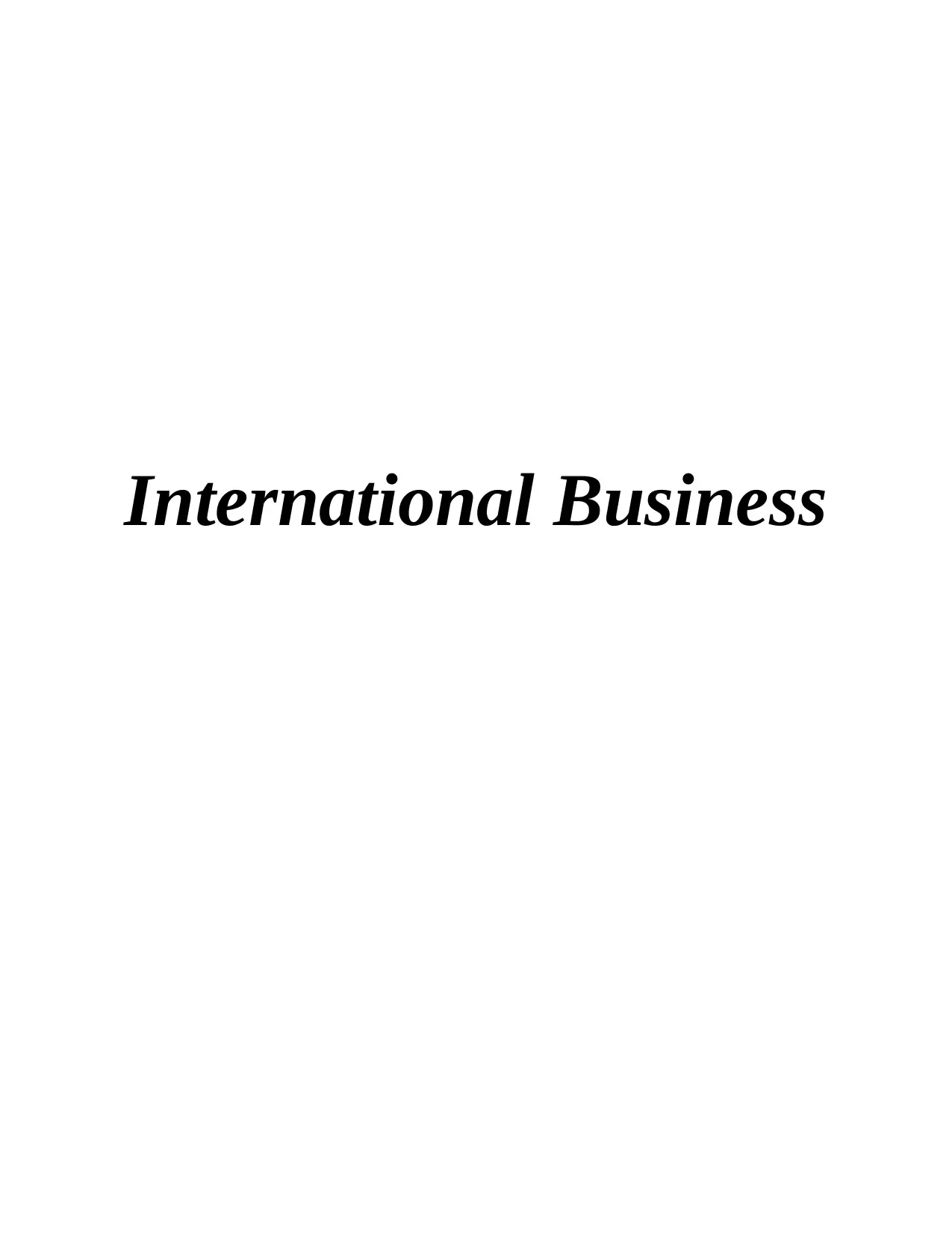
International Business
Paraphrase This Document
Need a fresh take? Get an instant paraphrase of this document with our AI Paraphraser
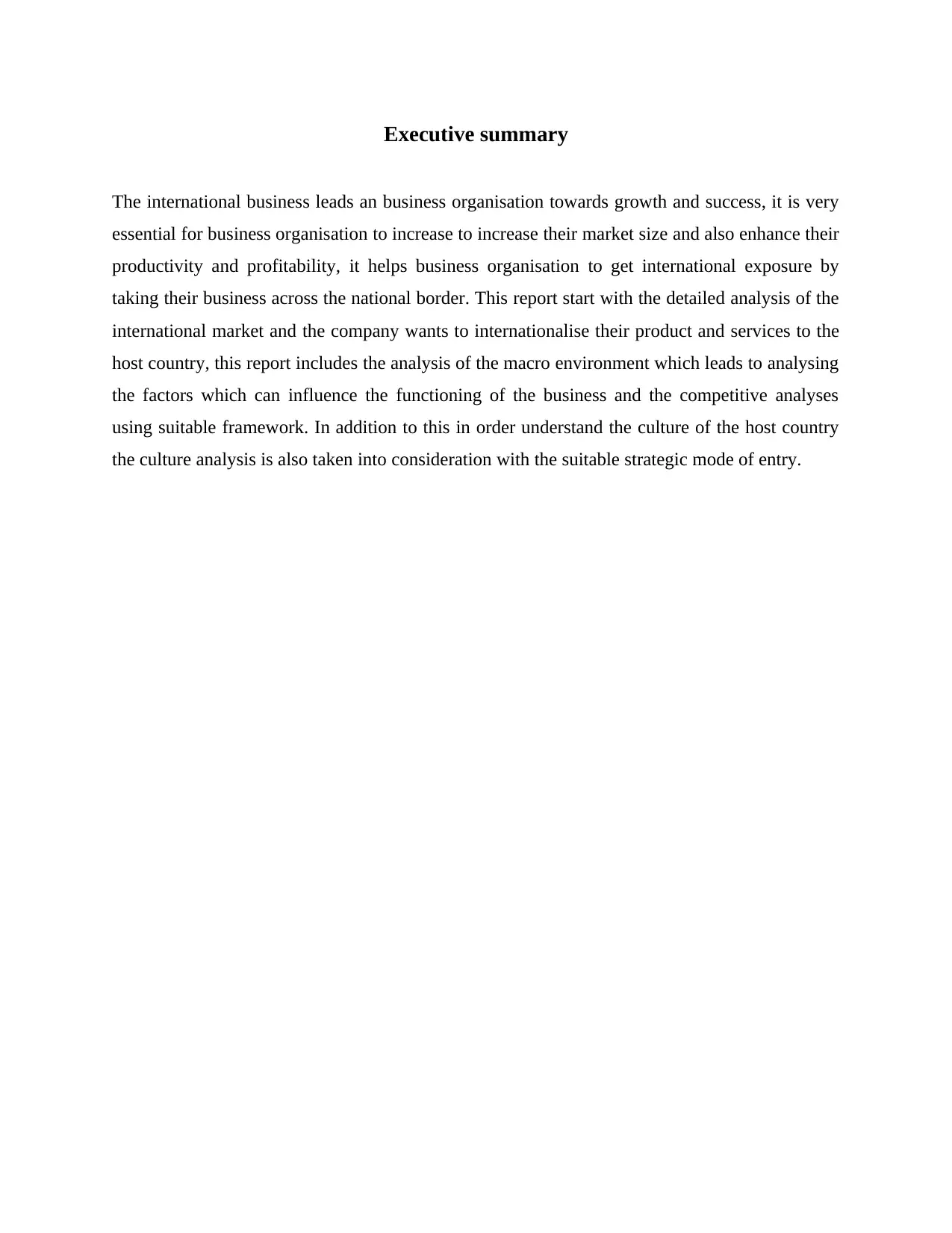
Executive summary
The international business leads an business organisation towards growth and success, it is very
essential for business organisation to increase to increase their market size and also enhance their
productivity and profitability, it helps business organisation to get international exposure by
taking their business across the national border. This report start with the detailed analysis of the
international market and the company wants to internationalise their product and services to the
host country, this report includes the analysis of the macro environment which leads to analysing
the factors which can influence the functioning of the business and the competitive analyses
using suitable framework. In addition to this in order understand the culture of the host country
the culture analysis is also taken into consideration with the suitable strategic mode of entry.
The international business leads an business organisation towards growth and success, it is very
essential for business organisation to increase to increase their market size and also enhance their
productivity and profitability, it helps business organisation to get international exposure by
taking their business across the national border. This report start with the detailed analysis of the
international market and the company wants to internationalise their product and services to the
host country, this report includes the analysis of the macro environment which leads to analysing
the factors which can influence the functioning of the business and the competitive analyses
using suitable framework. In addition to this in order understand the culture of the host country
the culture analysis is also taken into consideration with the suitable strategic mode of entry.
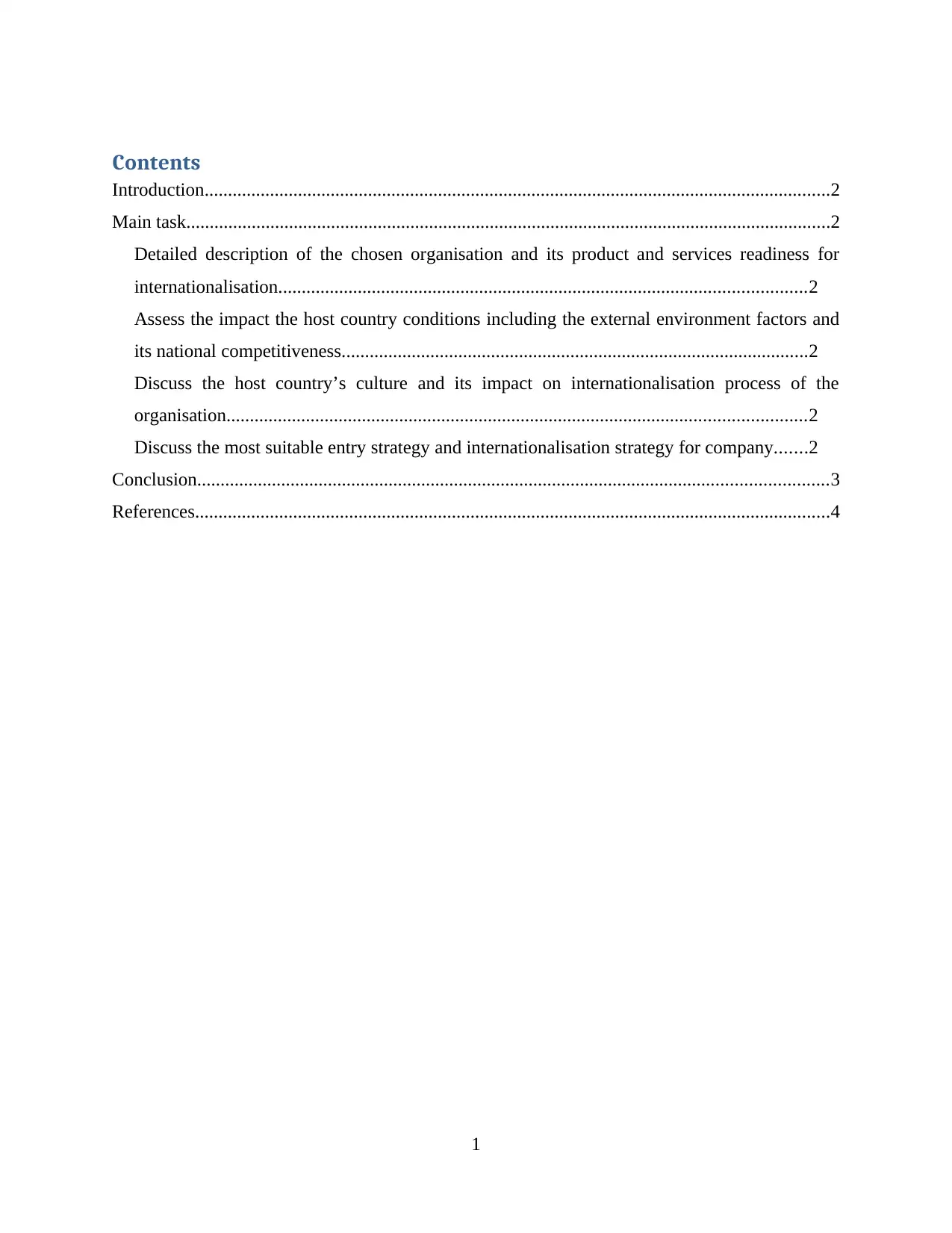
Contents
Introduction......................................................................................................................................2
Main task..........................................................................................................................................2
Detailed description of the chosen organisation and its product and services readiness for
internationalisation.................................................................................................................2
Assess the impact the host country conditions including the external environment factors and
its national competitiveness....................................................................................................2
Discuss the host country’s culture and its impact on internationalisation process of the
organisation............................................................................................................................2
Discuss the most suitable entry strategy and internationalisation strategy for company.......2
Conclusion.......................................................................................................................................3
References........................................................................................................................................4
1
Introduction......................................................................................................................................2
Main task..........................................................................................................................................2
Detailed description of the chosen organisation and its product and services readiness for
internationalisation.................................................................................................................2
Assess the impact the host country conditions including the external environment factors and
its national competitiveness....................................................................................................2
Discuss the host country’s culture and its impact on internationalisation process of the
organisation............................................................................................................................2
Discuss the most suitable entry strategy and internationalisation strategy for company.......2
Conclusion.......................................................................................................................................3
References........................................................................................................................................4
1
⊘ This is a preview!⊘
Do you want full access?
Subscribe today to unlock all pages.

Trusted by 1+ million students worldwide
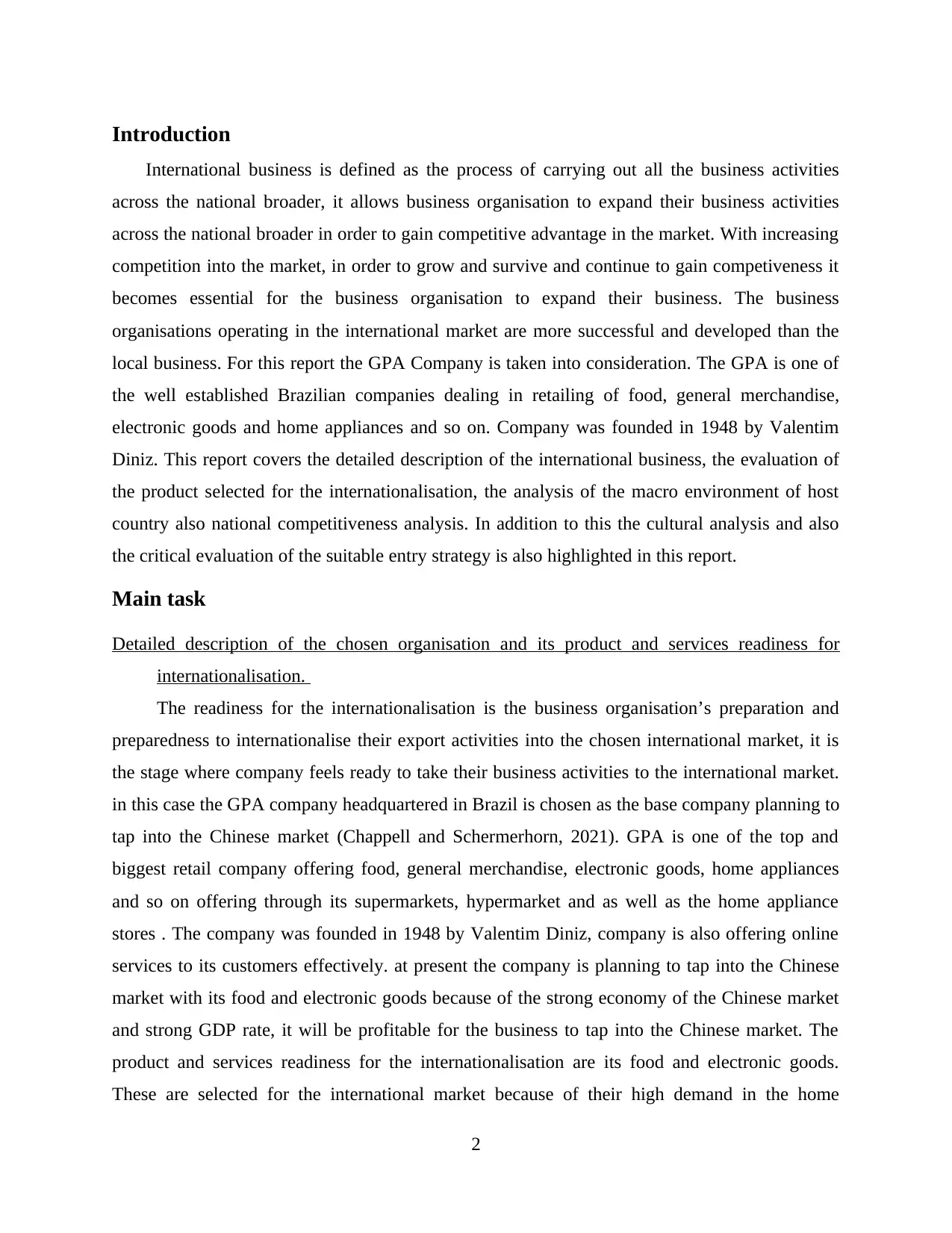
Introduction
International business is defined as the process of carrying out all the business activities
across the national broader, it allows business organisation to expand their business activities
across the national broader in order to gain competitive advantage in the market. With increasing
competition into the market, in order to grow and survive and continue to gain competiveness it
becomes essential for the business organisation to expand their business. The business
organisations operating in the international market are more successful and developed than the
local business. For this report the GPA Company is taken into consideration. The GPA is one of
the well established Brazilian companies dealing in retailing of food, general merchandise,
electronic goods and home appliances and so on. Company was founded in 1948 by Valentim
Diniz. This report covers the detailed description of the international business, the evaluation of
the product selected for the internationalisation, the analysis of the macro environment of host
country also national competitiveness analysis. In addition to this the cultural analysis and also
the critical evaluation of the suitable entry strategy is also highlighted in this report.
Main task
Detailed description of the chosen organisation and its product and services readiness for
internationalisation.
The readiness for the internationalisation is the business organisation’s preparation and
preparedness to internationalise their export activities into the chosen international market, it is
the stage where company feels ready to take their business activities to the international market.
in this case the GPA company headquartered in Brazil is chosen as the base company planning to
tap into the Chinese market (Chappell and Schermerhorn, 2021). GPA is one of the top and
biggest retail company offering food, general merchandise, electronic goods, home appliances
and so on offering through its supermarkets, hypermarket and as well as the home appliance
stores . The company was founded in 1948 by Valentim Diniz, company is also offering online
services to its customers effectively. at present the company is planning to tap into the Chinese
market with its food and electronic goods because of the strong economy of the Chinese market
and strong GDP rate, it will be profitable for the business to tap into the Chinese market. The
product and services readiness for the internationalisation are its food and electronic goods.
These are selected for the international market because of their high demand in the home
2
International business is defined as the process of carrying out all the business activities
across the national broader, it allows business organisation to expand their business activities
across the national broader in order to gain competitive advantage in the market. With increasing
competition into the market, in order to grow and survive and continue to gain competiveness it
becomes essential for the business organisation to expand their business. The business
organisations operating in the international market are more successful and developed than the
local business. For this report the GPA Company is taken into consideration. The GPA is one of
the well established Brazilian companies dealing in retailing of food, general merchandise,
electronic goods and home appliances and so on. Company was founded in 1948 by Valentim
Diniz. This report covers the detailed description of the international business, the evaluation of
the product selected for the internationalisation, the analysis of the macro environment of host
country also national competitiveness analysis. In addition to this the cultural analysis and also
the critical evaluation of the suitable entry strategy is also highlighted in this report.
Main task
Detailed description of the chosen organisation and its product and services readiness for
internationalisation.
The readiness for the internationalisation is the business organisation’s preparation and
preparedness to internationalise their export activities into the chosen international market, it is
the stage where company feels ready to take their business activities to the international market.
in this case the GPA company headquartered in Brazil is chosen as the base company planning to
tap into the Chinese market (Chappell and Schermerhorn, 2021). GPA is one of the top and
biggest retail company offering food, general merchandise, electronic goods, home appliances
and so on offering through its supermarkets, hypermarket and as well as the home appliance
stores . The company was founded in 1948 by Valentim Diniz, company is also offering online
services to its customers effectively. at present the company is planning to tap into the Chinese
market with its food and electronic goods because of the strong economy of the Chinese market
and strong GDP rate, it will be profitable for the business to tap into the Chinese market. The
product and services readiness for the internationalisation are its food and electronic goods.
These are selected for the international market because of their high demand in the home
2
Paraphrase This Document
Need a fresh take? Get an instant paraphrase of this document with our AI Paraphraser
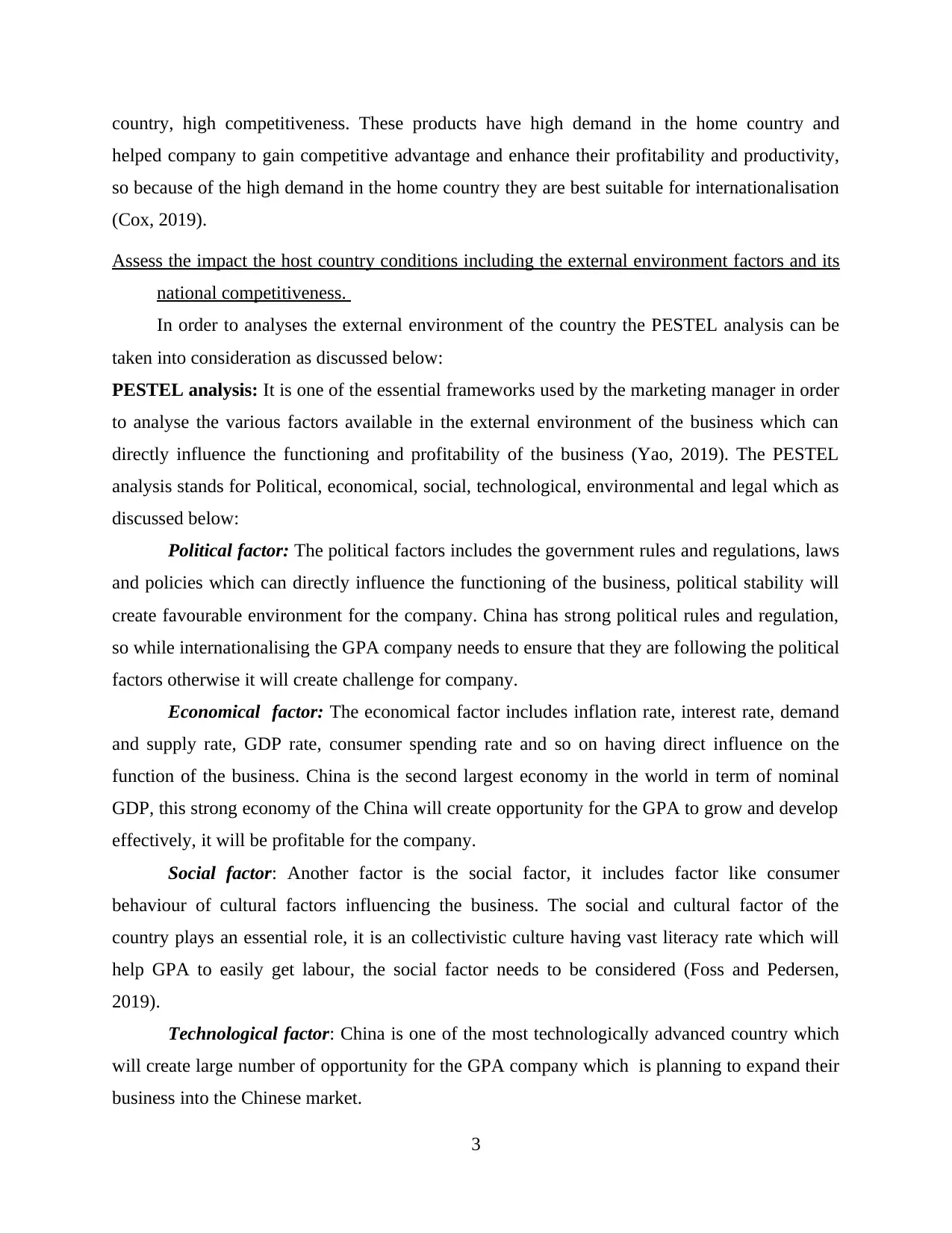
country, high competitiveness. These products have high demand in the home country and
helped company to gain competitive advantage and enhance their profitability and productivity,
so because of the high demand in the home country they are best suitable for internationalisation
(Cox, 2019).
Assess the impact the host country conditions including the external environment factors and its
national competitiveness.
In order to analyses the external environment of the country the PESTEL analysis can be
taken into consideration as discussed below:
PESTEL analysis: It is one of the essential frameworks used by the marketing manager in order
to analyse the various factors available in the external environment of the business which can
directly influence the functioning and profitability of the business (Yao, 2019). The PESTEL
analysis stands for Political, economical, social, technological, environmental and legal which as
discussed below:
Political factor: The political factors includes the government rules and regulations, laws
and policies which can directly influence the functioning of the business, political stability will
create favourable environment for the company. China has strong political rules and regulation,
so while internationalising the GPA company needs to ensure that they are following the political
factors otherwise it will create challenge for company.
Economical factor: The economical factor includes inflation rate, interest rate, demand
and supply rate, GDP rate, consumer spending rate and so on having direct influence on the
function of the business. China is the second largest economy in the world in term of nominal
GDP, this strong economy of the China will create opportunity for the GPA to grow and develop
effectively, it will be profitable for the company.
Social factor: Another factor is the social factor, it includes factor like consumer
behaviour of cultural factors influencing the business. The social and cultural factor of the
country plays an essential role, it is an collectivistic culture having vast literacy rate which will
help GPA to easily get labour, the social factor needs to be considered (Foss and Pedersen,
2019).
Technological factor: China is one of the most technologically advanced country which
will create large number of opportunity for the GPA company which is planning to expand their
business into the Chinese market.
3
helped company to gain competitive advantage and enhance their profitability and productivity,
so because of the high demand in the home country they are best suitable for internationalisation
(Cox, 2019).
Assess the impact the host country conditions including the external environment factors and its
national competitiveness.
In order to analyses the external environment of the country the PESTEL analysis can be
taken into consideration as discussed below:
PESTEL analysis: It is one of the essential frameworks used by the marketing manager in order
to analyse the various factors available in the external environment of the business which can
directly influence the functioning and profitability of the business (Yao, 2019). The PESTEL
analysis stands for Political, economical, social, technological, environmental and legal which as
discussed below:
Political factor: The political factors includes the government rules and regulations, laws
and policies which can directly influence the functioning of the business, political stability will
create favourable environment for the company. China has strong political rules and regulation,
so while internationalising the GPA company needs to ensure that they are following the political
factors otherwise it will create challenge for company.
Economical factor: The economical factor includes inflation rate, interest rate, demand
and supply rate, GDP rate, consumer spending rate and so on having direct influence on the
function of the business. China is the second largest economy in the world in term of nominal
GDP, this strong economy of the China will create opportunity for the GPA to grow and develop
effectively, it will be profitable for the company.
Social factor: Another factor is the social factor, it includes factor like consumer
behaviour of cultural factors influencing the business. The social and cultural factor of the
country plays an essential role, it is an collectivistic culture having vast literacy rate which will
help GPA to easily get labour, the social factor needs to be considered (Foss and Pedersen,
2019).
Technological factor: China is one of the most technologically advanced country which
will create large number of opportunity for the GPA company which is planning to expand their
business into the Chinese market.
3

Environmental factor: working towards the welfare and sustainability of the
environment will help company to gain competitive environment, Chinese market strictly
follows the values. So GPA needs to ensure that they are working towards the welfare and
sustainability of the environment in Chinese market ( Tuomisalo, and Leppäaho, 2019).
Legal factor: It includes factors like legal laws rules, legislation which needs to be
followed by each and everyone, strict legal laws will create challenge for the international
companies and vice versa. The GPA needs to ensure that they are following the legal laws.
From the above discussion it can be concluded that proper analysis of the Chinese
external market will help GPA company to easily internationalise their products into the Chinese
market, china has strong economic and technology factors which will help company to grow and
enhance it profitability (Gereffi, 2019).
In order to analyse the national competitiveness the SWOT analysis can be taken into
consideration as discussed below:
SWOT analysis: It is defined as the framework used by the by the marketing manager in order
to analyse the internal factors which can influence the functioning and profitability of the
business. The SWOT analysis stand for Strength, weakness, opportunity and threat which are as
discussed below:
Strength Weakness
One the biggest strength of the country
that it is the second largest economy in
the world.
There is a boom in the telecom sector
which vast number of mobile
subscriptions effectively.
It offers cheap labour and also large
potential market for the employment.
One of the biggest weakness is the high
unemployment rate in the country
because of the high population.
There are strict restrictions in property
sale imposed by the local government.
Opportunity Threat
Focus on the urban migration can be an
opportunity for the country.
Another opportunity for the country can
be the more focus on the service sector
On the threat for the country can be the
increasing globe competition.
Creating negative perception on the
country can be another threat for the
4
environment will help company to gain competitive environment, Chinese market strictly
follows the values. So GPA needs to ensure that they are working towards the welfare and
sustainability of the environment in Chinese market ( Tuomisalo, and Leppäaho, 2019).
Legal factor: It includes factors like legal laws rules, legislation which needs to be
followed by each and everyone, strict legal laws will create challenge for the international
companies and vice versa. The GPA needs to ensure that they are following the legal laws.
From the above discussion it can be concluded that proper analysis of the Chinese
external market will help GPA company to easily internationalise their products into the Chinese
market, china has strong economic and technology factors which will help company to grow and
enhance it profitability (Gereffi, 2019).
In order to analyse the national competitiveness the SWOT analysis can be taken into
consideration as discussed below:
SWOT analysis: It is defined as the framework used by the by the marketing manager in order
to analyse the internal factors which can influence the functioning and profitability of the
business. The SWOT analysis stand for Strength, weakness, opportunity and threat which are as
discussed below:
Strength Weakness
One the biggest strength of the country
that it is the second largest economy in
the world.
There is a boom in the telecom sector
which vast number of mobile
subscriptions effectively.
It offers cheap labour and also large
potential market for the employment.
One of the biggest weakness is the high
unemployment rate in the country
because of the high population.
There are strict restrictions in property
sale imposed by the local government.
Opportunity Threat
Focus on the urban migration can be an
opportunity for the country.
Another opportunity for the country can
be the more focus on the service sector
On the threat for the country can be the
increasing globe competition.
Creating negative perception on the
country can be another threat for the
4
⊘ This is a preview!⊘
Do you want full access?
Subscribe today to unlock all pages.

Trusted by 1+ million students worldwide
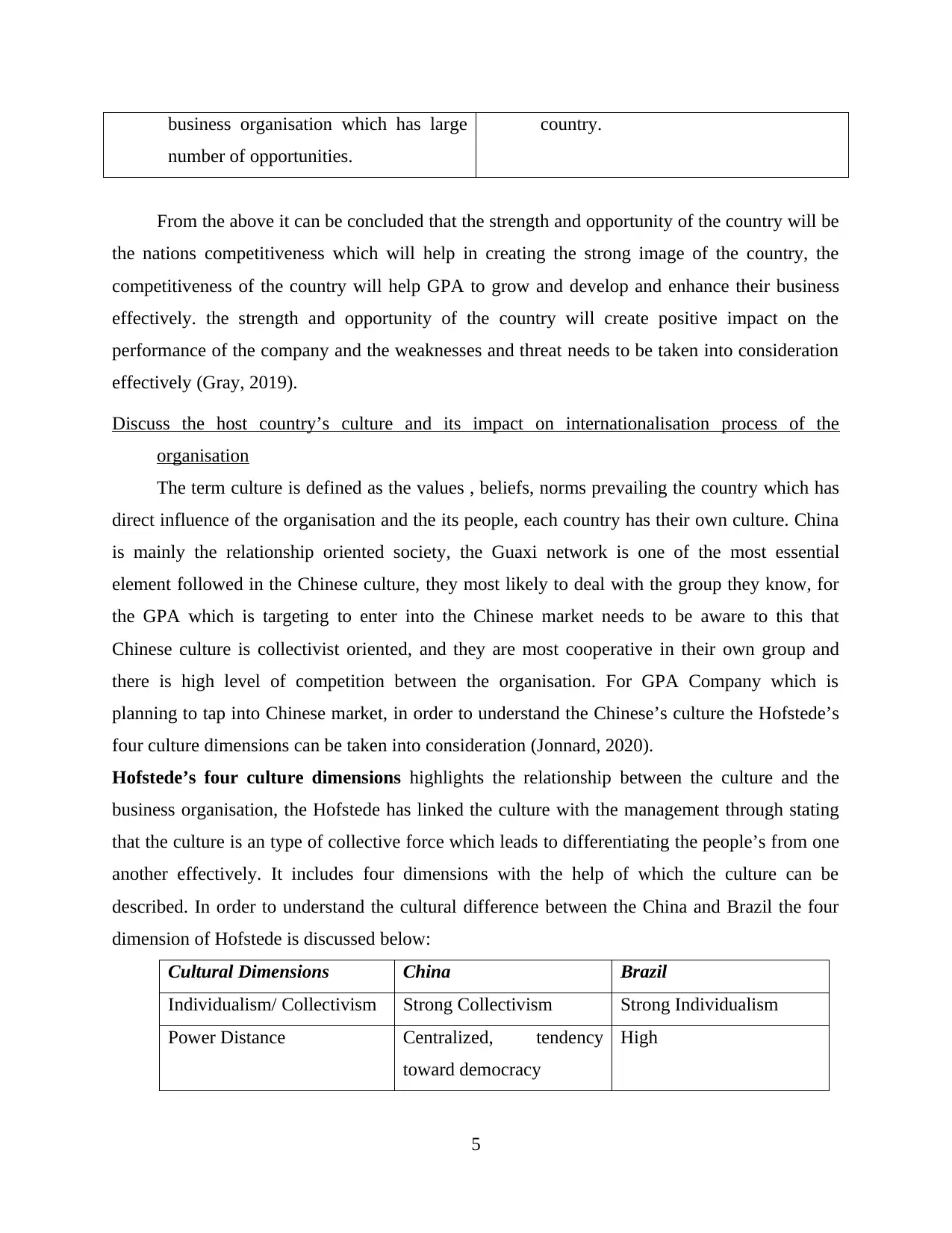
business organisation which has large
number of opportunities.
country.
From the above it can be concluded that the strength and opportunity of the country will be
the nations competitiveness which will help in creating the strong image of the country, the
competitiveness of the country will help GPA to grow and develop and enhance their business
effectively. the strength and opportunity of the country will create positive impact on the
performance of the company and the weaknesses and threat needs to be taken into consideration
effectively (Gray, 2019).
Discuss the host country’s culture and its impact on internationalisation process of the
organisation
The term culture is defined as the values , beliefs, norms prevailing the country which has
direct influence of the organisation and the its people, each country has their own culture. China
is mainly the relationship oriented society, the Guaxi network is one of the most essential
element followed in the Chinese culture, they most likely to deal with the group they know, for
the GPA which is targeting to enter into the Chinese market needs to be aware to this that
Chinese culture is collectivist oriented, and they are most cooperative in their own group and
there is high level of competition between the organisation. For GPA Company which is
planning to tap into Chinese market, in order to understand the Chinese’s culture the Hofstede’s
four culture dimensions can be taken into consideration (Jonnard, 2020).
Hofstede’s four culture dimensions highlights the relationship between the culture and the
business organisation, the Hofstede has linked the culture with the management through stating
that the culture is an type of collective force which leads to differentiating the people’s from one
another effectively. It includes four dimensions with the help of which the culture can be
described. In order to understand the cultural difference between the China and Brazil the four
dimension of Hofstede is discussed below:
Cultural Dimensions China Brazil
Individualism/ Collectivism Strong Collectivism Strong Individualism
Power Distance Centralized, tendency
toward democracy
High
5
number of opportunities.
country.
From the above it can be concluded that the strength and opportunity of the country will be
the nations competitiveness which will help in creating the strong image of the country, the
competitiveness of the country will help GPA to grow and develop and enhance their business
effectively. the strength and opportunity of the country will create positive impact on the
performance of the company and the weaknesses and threat needs to be taken into consideration
effectively (Gray, 2019).
Discuss the host country’s culture and its impact on internationalisation process of the
organisation
The term culture is defined as the values , beliefs, norms prevailing the country which has
direct influence of the organisation and the its people, each country has their own culture. China
is mainly the relationship oriented society, the Guaxi network is one of the most essential
element followed in the Chinese culture, they most likely to deal with the group they know, for
the GPA which is targeting to enter into the Chinese market needs to be aware to this that
Chinese culture is collectivist oriented, and they are most cooperative in their own group and
there is high level of competition between the organisation. For GPA Company which is
planning to tap into Chinese market, in order to understand the Chinese’s culture the Hofstede’s
four culture dimensions can be taken into consideration (Jonnard, 2020).
Hofstede’s four culture dimensions highlights the relationship between the culture and the
business organisation, the Hofstede has linked the culture with the management through stating
that the culture is an type of collective force which leads to differentiating the people’s from one
another effectively. It includes four dimensions with the help of which the culture can be
described. In order to understand the cultural difference between the China and Brazil the four
dimension of Hofstede is discussed below:
Cultural Dimensions China Brazil
Individualism/ Collectivism Strong Collectivism Strong Individualism
Power Distance Centralized, tendency
toward democracy
High
5
Paraphrase This Document
Need a fresh take? Get an instant paraphrase of this document with our AI Paraphraser

Uncertainty Avoidance Risk-avoiding Risk-taking
Masculinity/Femininity More Feminine More Masculine
Long-short-term Orientation Long-term Orientation Short-term Orientation
For the GPA company before entering the Chinese market the above mentioned the
cultural dimensions of the Chinese market needs to be carefully evaluated and analysed for better
and smooth functioning into the Chinese market and enhance their productivity and profitability
(Kurzer, 2019).
Discuss the most suitable entry strategy and internationalisation strategy for company.
In order to enter into the Chinese market the GPA Company can use number of entry
strategy available, some of the most suitable entry strategy are discussed below:
Exporting: one of the most essential methods that can be used by the business
organisation in order to enter into the international market is the exporting. Exporting is the
process of direct sale of the goods and services into the host country, it allows company to have
direct excess to the international market with low risk availability (Pathak, 2018).
Licensing: It is the process which allows another business organisation in the selected
international market to use your property. The licensee will be paying certain amount as per the
agreement to be able to use the property.
Franchising: Another method is the franchising, under this the intellectual property rights are
sold to the franchisee in order to carry out their business.
Joint Venture: under this the company join with another company in the host country in
order to carry out the business jointly, it allow easy access to the international market.
From the above discuss, in order to enter into the international market the GPA company can
use direct exporting method, this will allow company to directly sell their product and services
into the Chinese market, also allow to have direct control over their product and services and
over international market effectively (Stout-Rostron, 2018). Company can use direct expansion
and target market strategy for their internationalisation strategy.
6
Masculinity/Femininity More Feminine More Masculine
Long-short-term Orientation Long-term Orientation Short-term Orientation
For the GPA company before entering the Chinese market the above mentioned the
cultural dimensions of the Chinese market needs to be carefully evaluated and analysed for better
and smooth functioning into the Chinese market and enhance their productivity and profitability
(Kurzer, 2019).
Discuss the most suitable entry strategy and internationalisation strategy for company.
In order to enter into the Chinese market the GPA Company can use number of entry
strategy available, some of the most suitable entry strategy are discussed below:
Exporting: one of the most essential methods that can be used by the business
organisation in order to enter into the international market is the exporting. Exporting is the
process of direct sale of the goods and services into the host country, it allows company to have
direct excess to the international market with low risk availability (Pathak, 2018).
Licensing: It is the process which allows another business organisation in the selected
international market to use your property. The licensee will be paying certain amount as per the
agreement to be able to use the property.
Franchising: Another method is the franchising, under this the intellectual property rights are
sold to the franchisee in order to carry out their business.
Joint Venture: under this the company join with another company in the host country in
order to carry out the business jointly, it allow easy access to the international market.
From the above discuss, in order to enter into the international market the GPA company can
use direct exporting method, this will allow company to directly sell their product and services
into the Chinese market, also allow to have direct control over their product and services and
over international market effectively (Stout-Rostron, 2018). Company can use direct expansion
and target market strategy for their internationalisation strategy.
6

Conclusion
From the above discussion it can be concluded that international business allows business
organisation to expand their market size and gain competitive advantage in the market, it helps
business to get international exposure and enhance their profitability and productivity effectively
and also increase their customer base. International business involves marketing all the business
product and services outside the national boundary. It is very essential for the business to get the
international exposure in order to gain competitive advantage in the growing competitive
environment. This report highlights the importance of international business, and description of
the products ready for the internationalisation with the detailed analysis of the macro
environment. in addition to this competitive analysis of the host country and the cultural analysis
is also highlighted in this report.
7
From the above discussion it can be concluded that international business allows business
organisation to expand their market size and gain competitive advantage in the market, it helps
business to get international exposure and enhance their profitability and productivity effectively
and also increase their customer base. International business involves marketing all the business
product and services outside the national boundary. It is very essential for the business to get the
international exposure in order to gain competitive advantage in the growing competitive
environment. This report highlights the importance of international business, and description of
the products ready for the internationalisation with the detailed analysis of the macro
environment. in addition to this competitive analysis of the host country and the cultural analysis
is also highlighted in this report.
7
⊘ This is a preview!⊘
Do you want full access?
Subscribe today to unlock all pages.

Trusted by 1+ million students worldwide
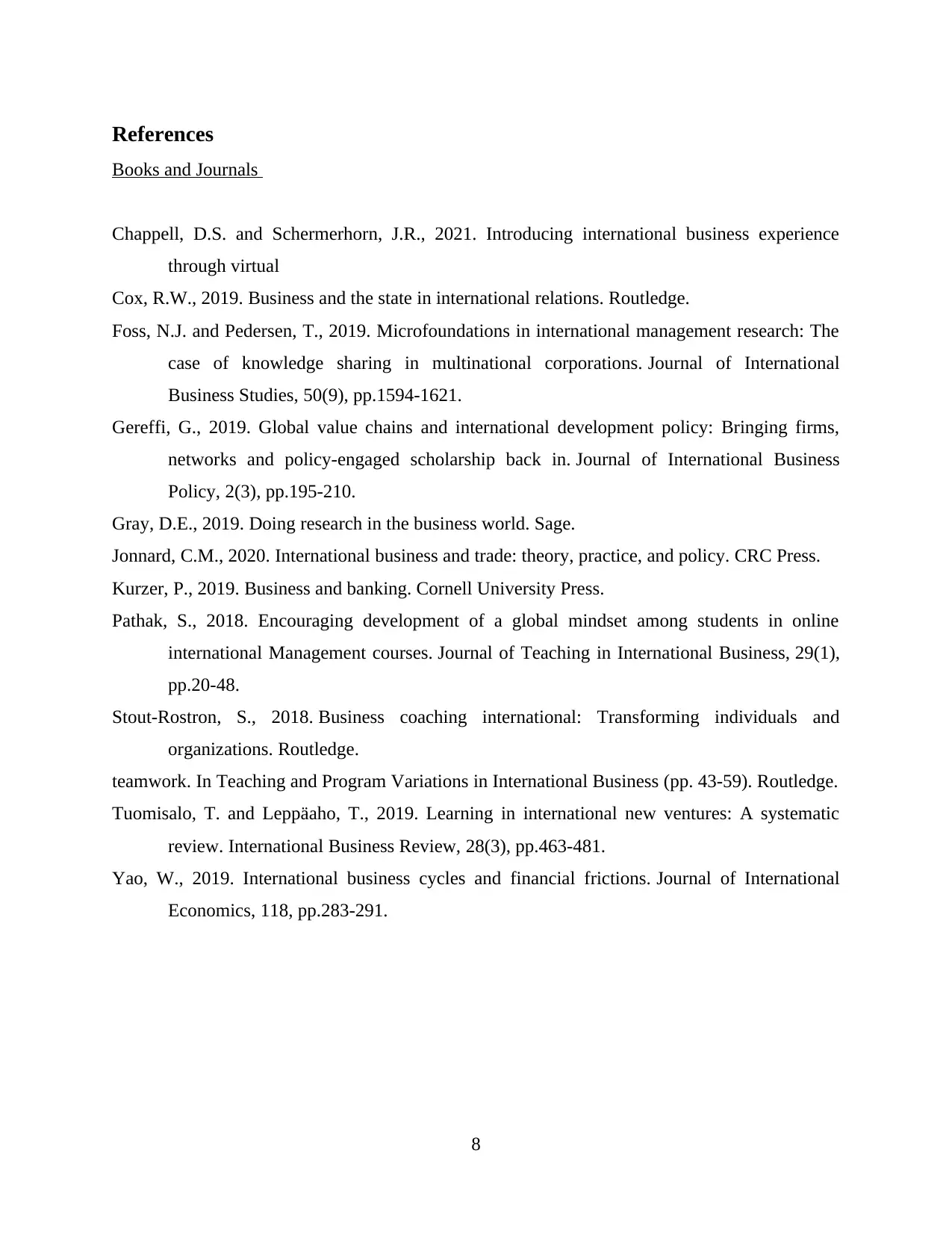
References
Books and Journals
Chappell, D.S. and Schermerhorn, J.R., 2021. Introducing international business experience
through virtual
Cox, R.W., 2019. Business and the state in international relations. Routledge.
Foss, N.J. and Pedersen, T., 2019. Microfoundations in international management research: The
case of knowledge sharing in multinational corporations. Journal of International
Business Studies, 50(9), pp.1594-1621.
Gereffi, G., 2019. Global value chains and international development policy: Bringing firms,
networks and policy-engaged scholarship back in. Journal of International Business
Policy, 2(3), pp.195-210.
Gray, D.E., 2019. Doing research in the business world. Sage.
Jonnard, C.M., 2020. International business and trade: theory, practice, and policy. CRC Press.
Kurzer, P., 2019. Business and banking. Cornell University Press.
Pathak, S., 2018. Encouraging development of a global mindset among students in online
international Management courses. Journal of Teaching in International Business, 29(1),
pp.20-48.
Stout-Rostron, S., 2018. Business coaching international: Transforming individuals and
organizations. Routledge.
teamwork. In Teaching and Program Variations in International Business (pp. 43-59). Routledge.
Tuomisalo, T. and Leppäaho, T., 2019. Learning in international new ventures: A systematic
review. International Business Review, 28(3), pp.463-481.
Yao, W., 2019. International business cycles and financial frictions. Journal of International
Economics, 118, pp.283-291.
8
Books and Journals
Chappell, D.S. and Schermerhorn, J.R., 2021. Introducing international business experience
through virtual
Cox, R.W., 2019. Business and the state in international relations. Routledge.
Foss, N.J. and Pedersen, T., 2019. Microfoundations in international management research: The
case of knowledge sharing in multinational corporations. Journal of International
Business Studies, 50(9), pp.1594-1621.
Gereffi, G., 2019. Global value chains and international development policy: Bringing firms,
networks and policy-engaged scholarship back in. Journal of International Business
Policy, 2(3), pp.195-210.
Gray, D.E., 2019. Doing research in the business world. Sage.
Jonnard, C.M., 2020. International business and trade: theory, practice, and policy. CRC Press.
Kurzer, P., 2019. Business and banking. Cornell University Press.
Pathak, S., 2018. Encouraging development of a global mindset among students in online
international Management courses. Journal of Teaching in International Business, 29(1),
pp.20-48.
Stout-Rostron, S., 2018. Business coaching international: Transforming individuals and
organizations. Routledge.
teamwork. In Teaching and Program Variations in International Business (pp. 43-59). Routledge.
Tuomisalo, T. and Leppäaho, T., 2019. Learning in international new ventures: A systematic
review. International Business Review, 28(3), pp.463-481.
Yao, W., 2019. International business cycles and financial frictions. Journal of International
Economics, 118, pp.283-291.
8
1 out of 10
Related Documents
Your All-in-One AI-Powered Toolkit for Academic Success.
+13062052269
info@desklib.com
Available 24*7 on WhatsApp / Email
![[object Object]](/_next/static/media/star-bottom.7253800d.svg)
Unlock your academic potential
Copyright © 2020–2025 A2Z Services. All Rights Reserved. Developed and managed by ZUCOL.




